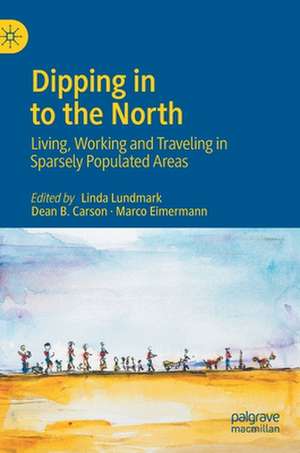Dipping in to the North: Living, Working and Traveling in Sparsely Populated Areas
Editat de Linda Lundmark, Dean B. Carson, Marco Eimermannen Limba Engleză Hardback – 2 dec 2020
| Toate formatele și edițiile | Preț | Express |
|---|---|---|
| Paperback (1) | 392.60 lei 6-8 săpt. | |
| Springer Nature Singapore – 3 dec 2021 | 392.60 lei 6-8 săpt. | |
| Hardback (1) | 399.12 lei 6-8 săpt. | |
| Springer Nature Singapore – 2 dec 2020 | 399.12 lei 6-8 săpt. |
Preț: 399.12 lei
Nou
Puncte Express: 599
Preț estimativ în valută:
76.39€ • 78.72$ • 64.49£
76.39€ • 78.72$ • 64.49£
Carte tipărită la comandă
Livrare economică 01-15 martie
Preluare comenzi: 021 569.72.76
Specificații
ISBN-13: 9789811566226
ISBN-10: 9811566224
Pagini: 411
Ilustrații: XXVIII, 411 p. 43 illus., 32 illus. in color.
Dimensiuni: 148 x 210 mm
Greutate: 0.68 kg
Ediția:1st ed. 2020
Editura: Springer Nature Singapore
Colecția Palgrave Macmillan
Locul publicării:Singapore, Singapore
ISBN-10: 9811566224
Pagini: 411
Ilustrații: XXVIII, 411 p. 43 illus., 32 illus. in color.
Dimensiuni: 148 x 210 mm
Greutate: 0.68 kg
Ediția:1st ed. 2020
Editura: Springer Nature Singapore
Colecția Palgrave Macmillan
Locul publicării:Singapore, Singapore
Cuprins
1. Dipping in to the North: Living, Working and Traveling in Sparsely Populated Areas.- 2. Who Lives in the Inland North? Dynamic, Diverse, Fragile, Robust.- 3. Small Villages and Socio-Economic Change in Resource Peripheries: A View from Northern Sweden.- 4. The Myth of the Immobile Rural: The Case of Rural Villages in Iceland.- 5. The Changing Youth Population.- 6. Housing in SPAs: Too Much of Nothing or Too Much for ‘Free’?.- 7. Lifestyle Migrants and Intercultural Communication in Swedish Villages.- 8. Who Works in the North? Challenges and Opportunities for Employment.- 9. Tradition Is Essential: Clashing Articulations of Sami Identity, Past and Present.- 10. A Socially Accountable Health and Care Workforce in Northern Sweden: Who Should It Contain, Who Is It for and What Should It Do?.- 11. Is Downshifting Easier in the Countryside? Focus Group Visions on Individual Sustainability Transitions.- 12. Stayin’ Alive: New Associations in Southern Lapland Farming.- 13. Spicy Meatballs and Mango Sylt: Exploring Food Practices as a Means to Promoting Entrepreneurship in Rural Sweden.- 14. Who Travels to the North? Challenges and Opportunities for Tourism.- 15. Cities of the North: Gateways, Competitors or Regional Markets for Hinterland Tourism Destinations?.- 16. Strategic Objective? Contemporary Discourse on Russian Second-Home Ownership in Finland.- 17. Selling Greenness.- 18. Arctification and the Paradox of Overtourism in Sparsely Populated Areas.- 19. Tourism, Seasonality and the Attraction of Youth.- 20 Epilogue: From Growth to Decline to Degrowth? The Future of Northern SPAs.
Notă biografică
Linda Lundmark is Associate Professor at the Department of Geography at Umeå University, Sweden.
Dean Bradley Carson is Research Professor with the Centre for Tourism and Regional Opportunities at CQUniversity (Australia), and a Guest Professor with the Arctic Research Centre at Umeå University.
Marco Eimermann is Research Assistant Professor at the Department of Geography, and affiliated with the Arctic Research Centre, Umeå University.
Textul de pe ultima copertă
Dipping in to the North explores how changing mobility and migration is affecting the social, economic, cultural, and environmental characteristics of sparsely populated areas of northern Sweden (and places like it). It examines who lives in, works in, and visits the north; how and why this has changed over time; and what those changes mean for how the north might develop in the future. The book draws upon deep expertise and knowledge from a range of social scientists, presenting valuable insights in an accessible style for a broad audience.
Caracteristici
Offers the first cohesive and wide ranging examination of how northern communities might gain or lose from emerging and persistent mobility and migration flows Ambitiously attempts to come to grips with the relationships between mobilities, economies, societies and geographies Offers the expertise and knowledge of cultural geographers, economists, social historians and demographers who have been researching mobility issues in the north for the past two decades or more
